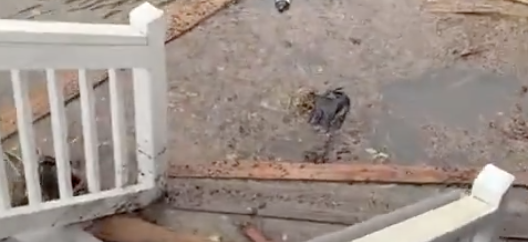The rainfall from Hurricane Helene has been catastrophic for many areas in its path. Florida, Georgia, North Carolina, South Carolina and Tennessee have been devastated.
Look at this!
This is absolutely terrifying. I don’t know if it’s possible for some people to evacuate at this point. Praying for #asheville#lakeluredam #lakelure #helene #ncwx pic.twitter.com/EfbC62xBlZ
— Frank Fighting For Freedom 🇺🇸 (@thinktankfranks) September 27, 2024
And with all this water comes the risk of displaced creatures. In States where alligators, crocodiles and venomous snakes are present, residents should be on high alert.
🚨FL & GA – Avoid WADING in Murky Water🔺
— Teeshasmom 🪶 🇺🇸 💝 🐾 🌊🌻 🌎🟦🟧 (@Teeshasmom2) September 28, 2024
🐊 GATORS Are NOW Scavenging After Hurricane Helene‼️
Watch Out for Water Moccasin SNAKES
They’re Good Swimmers & Looking for Higher Ground
👋Anyone besides me
Remember the Swimming Snakes of Hurricane Katrina⁉️pic.twitter.com/vKlQPUy9Yl
Snakes are washed from their burrows, alligators again extra hunting grounds. Take care. Check everything. Wear thick gloves and boots when clearing debris. Snakes love to hide in nooks and crannies. Cupboards, totes, driers (they go in through the outlet pipe), car engines are popular. And look up! Roof spaces, pergolas, trees are all potential high ground for climbing creatures.
Gators
Following Hurricane Helene’s landfall, reports and videos from residents and local media captured alligators swimming through the flooded thoroughfares of places like Sarasota, Siesta Key, and other affected areas. These sightings extended beyond natural water bodies into residential neighborhoods, showcasing the sheer scale of flooding and wildlife displacement.
🚨🇺🇸 Authorities warn of Alligators swimming in the Florida floodwaters.#Hurricane #Helene pic.twitter.com/bUDaKj3EgU
— Terror Alarm (@Terror_Alarm) September 27, 2024
Why Alligators? The flooding caused by Helene, a Category 4 hurricane at landfall, not only displaced human lives but also wildlife. Alligators, native to Florida’s wetlands, find themselves navigating new territories as floodwaters connect previously separated water bodies. This displacement isn’t new with hurricanes, but Helene’s intensity and the extensive flooding made these sightings more widespread and noticeable.
Dangers and Warnings: The presence of alligators in urban areas post-Helene underscores a significant risk to public safety. Florida wildlife officials and local authorities have been quick to issue warnings:
Avoid Floodwaters: The primary advice has been to avoid contact with floodwaters not just because of alligators but due to the myriad dangers posed by such conditions, including electrical hazards, contaminated water, and other wildlife like snakes.
Stay Alert: Residents are urged to remain vigilant even after the storm has passed. Alligators, along with other displaced wildlife like snakes and potentially bears, could be more aggressive due to their disorientation.
Do Not Feed or Approach Wildlife: While it might seem obvious, the stress of these natural events can make animals behave unpredictably, and feeding them could lead to dangerous human-wildlife interactions.
Snakes
- Although less visible than alligators, snakes, particularly venomous species like rattlesnakes, cottonmouths (water moccasins), and coral snakes, might also be displaced by flooding. Their presence in unusual locations, like flooded streets or homes, could lead to unexpected encounters, increasing the risk of snakebites.
Eastern Rat Snake (4ft) getting dry after remnants of Hurricane Helene #Wilmington #HurricaneHelene pic.twitter.com/jjrNQsUK1e
— Kevin Cearfoss (@GashouseILM) September 27, 2024
- Behavioral Changes: The stress of flooding and displacement can make snakes more aggressive or defensive, increasing the likelihood of bites. Additionally, the lack of natural predators in urban areas temporarily flooded can lead to increased snake activity as they seek new territories or prey.
- Warnings and Precautions:
- Avoid Floodwaters: The general advice to avoid floodwaters isn’t just about water depth or alligators but also about the hidden dangers like snakes.
- Protective Measures: For residents dealing with cleanup or returning to their properties, wearing protective clothing, using caution when moving debris, and being alert in any water or overgrowth can minimize snakebite risks. Tumble driers in my experience should be treated with caution.
But can you kill them?
Many people may not be aware of this, the fact is that in many states it IS illegal to kill a snake. So you may want to think twice before you grab that shovel! Check here for states with rules.
Other risks
Storms bring humidity, dampness, fallen trees, rotten wood, carcasses and debris. These creatures will thrive.
- Mosquitos
- Carpenter Ants
- Fire Ants
- Flies
- Wasps and Bees
- Termites
- Rats and mice
- Cockroaches
